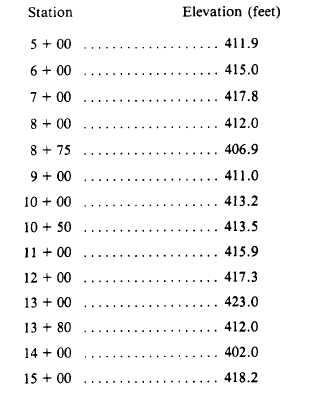PROFILE PLOTTING.— Make profile plotting
on regular profile paper that has ruled horizontal
and vertical parallel lines, as shown in figure
14-22. Vertical lines are spaced 1/4 or 1/2 in.
apart; horizontal lines are spaced 1/20 or 1/10 in.
apart. In figure 14-22, the vertical lines on the
original paper (reduced in size for reproduction
in this book) were 1/4 in. apart. On the original
paper, there was a horizontal line at every 1/20-in.
interval; for the sake of clarity, only those at every
1/4-in. interval have been reproduced.
For the first consideration in profile plotting,
select suitable horizontal and vertical scales
for the profile paper. The suitability of scales
varies with the character of the ground and other
factors. In figure 14-22, the horizontal scale
used was 1 in. = 400 ft, and the vertical scale
used was 1 in. = 20 ft (reduced in size for
reproduction in this book). Normally, to facilitate
the plan plotting, choose scales that are propor-
tional numbers in multiples of ten, such as those
given above (H, 1 in. = 400 ft, and V, 1 in. = 20 ft).
Write the stations and elevations, as shown in
figure 14-22.
Plot the profile, usually from profile level
notes, though you may plot it from the elevations
obtained from the contour lines. Assume that
profile level notes indicate the following center-
line elevations at the following stations from
5 + 00 through 15 + 00.
As you can see, an elevation was taken at every
full station and also at every plus where there was
a significant change in elevation. Can you see now
how important it is to follow this last procedure?
If an elevation had not been taken at 8 + 75, the
drop that exists between 8 + 00 and 9 + 00 would
not show on the profile.
Check through the listed elevations, and see
how each of them was plotted as a point located
where a vertical line indicating the station inter-
sected a horizontal line indicating the elevation
of that station. Note, too, that usually stations
are labeled where the line crosses highways,
streams, and railroads.
Besides the profile of the existing terrain, the
vertical tangents of the proposed highway center
line have been plotted. The end elevation for each
of these (that is, the elevations of points of
vertical intersection [PVI]) were determined by the
design engineers. Various circumstances were
considered. One of the important ones was
facilitating, as much as possible, the filling of each
depression with an approximately equal volume
of cut taken from a nearby hump or from two
nearby humps.
The gradient, in terms of percentage of slope
(total rise or fall in feet per 100 horizontal feet),
is marked on each of the vertical tangents. This
percentage is computed for a tangent as follows.
For the tangent running from station 6 + 00 to
station 18 + 00, the total rise is the difference in
elevation, or
The horizontal distance between the stations is
1,200 ft. The percentage of slope, then, is the
value of x in the equation
For a tangent running from station 18 + 00
to station 26 + 00, the total slope downward is
the difference in elevation, or
The distance between the stations is 800 ft. The
percentage of slope then is the value of x in the
equation
14-28




